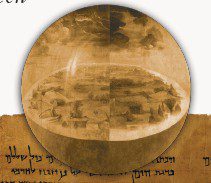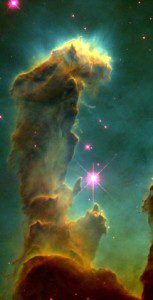 The next chapter of Kyle Greenwood’s new book Scripture and Cosmology: Reading the Bible Between the Ancient World and Modern Science looks at the range of creation or origins narratives in the Old Testament. Genesis 1 is the obvious place to start, but it is far from the only passage that deals with God’s role as creator. In fact he identifies thirteen different Old Testament passages that should help inform our interpretation of the creation narrative taught in Scripture.
The next chapter of Kyle Greenwood’s new book Scripture and Cosmology: Reading the Bible Between the Ancient World and Modern Science looks at the range of creation or origins narratives in the Old Testament. Genesis 1 is the obvious place to start, but it is far from the only passage that deals with God’s role as creator. In fact he identifies thirteen different Old Testament passages that should help inform our interpretation of the creation narrative taught in Scripture.
It is clear that the Bible as we have it is not a collection of propositions and facts. It is much closer to a diverse narrative telling of the relationship between God and his people, Israel and the church. Greenwood starts by bringing up the so-called synoptic problem. The four Gospels relate the life, death, and resurrection of Jesus but do so in different ways each with a different focus and slightly different purpose. The differences in the synoptic Gospels are particularly relevant to his point … who approached Jesus about the sick slave of the centurion, the centurion himself (Mt 8:6) or his friends (Lk 7:6)? Or for that matter, when did the fig tree wither, immediately (Mt 21) or by the next day (Mk 11)? These kinds of differences don’t discredit the Bible, but instead “demonstrate the multitextured nature of the biblical record.” This is not a discrepancy to be resolved but rather input that should inform the way we expect truth to be related in the narrative form of Scripture.
The thirteen different pictures of creation provided in the Old Testament are similar. They come in different forms with somewhat different purposes. These are not equivalent to the methods section of a scientific paper, but a narrative telling of relationship. The genres include stylized prose and poetry, not journalistic reports.
 Genesis 1 is the most familiar creation narrative in the Bible. Greenwood notes that “While it is a stretch to call Genesis 1 “poetry,” it is clear that it is highly stylized prose. The style of Genesis 1 is unlike any other prose in the Hebrew Bible.” (p. 106) The structure with three days forming creation followed by three days filling creation has been noted by many of the authors we have discussed over the last several years. This is the first clue that it is not a scientific methods account of origins. The author describes God as placing a roof over the earth to hold back “the waters that were above the dome” (1:7) This is not exactly the view of the earth that we hold today. The author had a three-tiered view of the cosmos that was common to the culture, but not in agreement with our modern view. That this ancient view was not corrected is another clue that the purpose of the creation account is not a scientific methods account of creation.
Genesis 1 is the most familiar creation narrative in the Bible. Greenwood notes that “While it is a stretch to call Genesis 1 “poetry,” it is clear that it is highly stylized prose. The style of Genesis 1 is unlike any other prose in the Hebrew Bible.” (p. 106) The structure with three days forming creation followed by three days filling creation has been noted by many of the authors we have discussed over the last several years. This is the first clue that it is not a scientific methods account of origins. The author describes God as placing a roof over the earth to hold back “the waters that were above the dome” (1:7) This is not exactly the view of the earth that we hold today. The author had a three-tiered view of the cosmos that was common to the culture, but not in agreement with our modern view. That this ancient view was not corrected is another clue that the purpose of the creation account is not a scientific methods account of creation.
Genesis 1 has a theological message. Among other things it is antimyth. The sun, moon, and stars are merely God’s creations. The occupants of the seas are God’s creation. The waters are held back and released by the word of God.
Genesis 2 provides a different (complementary) view of creation. The order of events is different – a clue that we don’t have a simple journalistic account in either chapter. More importantly, the Garden of Eden is a type of temple.
That Eden represents God’s temple, the intersection of heaven and earth, is evident from tabernacle and temple descriptions elsewhere in the Bible (e.g. Ex 25-40; 1 Kings 6; Ezek 47, Rev. 21-22). More specifically, Eden closely resembles the holy of holies. Both are populated with fruit trees (Gen 2:9; 1 Kings 6:29-35), with the Tree of Life occupying the center (Gen 2:9, 1 Kings 6:29-35, Rev 22:2). Rivers flow out of Eden as they flow out of the temple (Gen 2:10; Ezek 47:1, Rev 22:1), an especially relevant concept since the Tigris and Euphrates flow into the Persian Gulf rather than out of a common source. Both Eden and the temples were adorned with precious metals (Gen 2:11-12; Ex 25:10-31; 1 Kings 6:20; Rev 21:18-21). Angels guard the entrance (Gen 3:24; Ex 25:17-22, Ezek 1:5-11; Rev 21:12). All these factors point to the conclusion that Eden was not simply paradise for Adam and Eve; it was the intersection of heaven on earth. Eden was God’s sanctuary. It was the center of the cosmos. (p. 111-112)
Genesis 2 describes the preparation of God’s temple in the cosmos.
Exodus 20:8-11 recounts God’s creative process in terms of the three-tiered view of the universe. “For in six days the Lord made the heavens and the earth, the sea and all that is in them.”
Nehemiah 9:6 makes a similar statement: “You alone are the Lord. You made the heavens, even the highest heavens, and all their starry host, the earth and all that is on it, the seas and all that is in them.“
Job 38 describes creation as well. “In the opening thirty-seven verses of God’s monologue, God poetically describes the cosmos in terms of its three tiers and their principle parts. … God is in control over all three tiers of creation – earth, heavens and seas.” (p. 113-114)
Psalm 8 Humans are given dominion over the occupants of the three tiers of the cosmos – the birds of the sky, the beasts of the field, the creatures of the sea.
 Psalm 19 Creation, more specifically the highest tier of creation, the heavens, declare the glory of God. The sun moves across the whole earth illuminating the whole during the day.
Psalm 19 Creation, more specifically the highest tier of creation, the heavens, declare the glory of God. The sun moves across the whole earth illuminating the whole during the day.
Psalm 74:12-17
But God is my King from long ago;
he brings salvation on the earth.
It was you who split open the sea by your power;
you broke the heads of the monster in the waters.
It was you who crushed the heads of Leviathan
and gave it as food to the creatures of the desert.
It was you who opened up springs and streams;
you dried up the ever-flowing rivers.
The day is yours, and yours also the night;
you established the sun and moon.
It was you who set all the boundaries of the earth;
you made both summer and winter.
This is another description of creation. God established the sun and the moon and set the boundaries of the earth. Note as well that all three tiers are described. In addition to heavens and earth, God split open the sea and conquered the sea monsters; an image reminiscent of some of the Mesopotamian myths.
Psalm 104 “provides the most extensive account of creation outside of Genesis 1.” (p. 116) God creates the heavens (2-4), the earth (5-23) and the sea (25-26).
There is the sea, vast and spacious,
teeming with creatures beyond number—
living things both large and small.
There the ships go to and fro,
and Leviathan, which you formed to frolic there.
Whereas in Psalm 74 God’s power was demonstrated through the subjugation of the sea, in Psalm 104 God’s greatness is exhibited by the sea’s friendly creatures, including Leviathan, who plays in it. Here Leviathan is not a sea monster needing to be tamed, but just another of the sea’s inhabitants. (p. 117)
Psalm 136:1-9
Give thanks to the Lord of lords:
to him who alone does great wonders,
who by his understanding made the heavens,
who spread out the earth upon the waters,
who made the great lights—
the sun to govern the day,
the moon and stars to govern the night;
God made everything.
Proverbs 8:22-31. Here God is the source of all wisdom and has created everything with order and purpose.
Isaiah 40:12. “Each of the three parts of the cosmos was carefully apportioned by according to [God’s] specifications. … The waters (seas) were measured by the handful. The heavens were sized according to the span of his hands. The earth was weighed on scales, and its dust calculated with a gauge.” (p. 118)
Conclusions: Greenwood draws this together with several observations (quoted or paraphrased here from p. 119):
Six day creation is not a running theme. Aside from Genesis 1 the order of creation is more closely related to the ancient cosmological structure than it is to the structure of a week. The six days come up only twice – in Genesis 1 and as an allusion for Sabbath in Exodus 2o.
All of the accounts are poetic in nature. They use literary devices to convey the concepts. No part of the Bible takes a “scientific” approach to creation. It is literary and theological.
God is the author. The various creation accounts conform to the notion that God is the author of all aspects of the created order.
God is sovereign. There is no epic battle with creation.
The three-tiered cosmos runs through all of these accounts. The cosmos is divided into heavens, earth, and seas, and God is maker of all three.
God as creator of heavens, earth and seas is a common theme running through the Old Testament. A six-day creation is not. We see multifaceted poetic descriptions of creation using a variety of literary devices to convey meaning. The six-days of Genesis 1 is one of these devices; a literary format among other literary formats used to tell of creation. Like the variations found in the synoptic Gospels, these variations in creation accounts should help us understand the message and format of Scripture. We shouldn’t force it into a mold of our own making.
How do these various picture of creation help us understand Scripture?
How do they help us understand God as Creator?
If you wish to contact me directly you may do so at rjs4mail [at] att.net.
If interested you can subscribe to a full text feed of my posts at Musings on Science and Theology.















